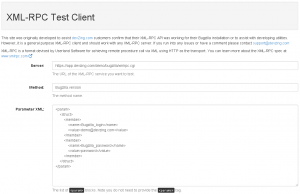From time to time we’ve had people wonder if the XML-RPC API is turned on for their Bugzilla installation. The answer is yes in all cases. Nevertheless it is difficult to verify as Bugzilla will not give you a meaningful response if you go to https://<mybugzilla>/xmlrpc.cgi in your browser.
Other clients want to verify some off error message they are getting from a tool that integrates with Bugzilla through the XML-RPC API.
To solve these questions we have deployed our online XML-RPC client.
By default it has the URL and credentials for our Bugzilla demo, but you can point it to any Bugzilla with XML-RPC enabled (even https://bugzilla.mozilla.org/).
The tricky bit is the parameter XML.
Bugzilla XML-RPC expects a single <struct> element. The names of the parameters listed in the API docs for each function are the <name> element for the struct <member>s. See Bugzilla::WebService::Server::XMLRPC and Bugzilla::WebService for more information.
For example
<param> <struct> <member> <name>Bugzilla_login</name> <value>demo@devzing.com</value> </member> <member> <name>Bugzilla_password</name> <value>password</value> </member> </struct> </param>
This is the minimum set of parameters for Bugzilla 4.4.x as almost all methods require authentication.
To retrieve a bug you need to set the method to Bug.get and parameter XML to something like the following:
<param>
<struct>
<member>
<name>Bugzilla_login</name>
<value>demo@devzing.com</value>
</member>
<member>
<name>Bugzilla_password</name>
<value>password</value>
</member>
<member>
<name>ids</name>
<value>
<array>
<data>
<value><i4>12</i4></value>
</data>
</array>
</value>
</member>
</struct>
</param>
For more information on how to represent various data types see the XML-RPC specification.
